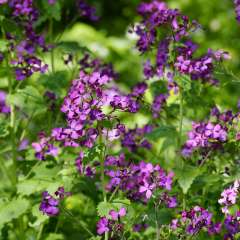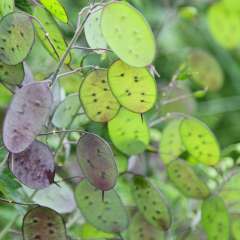Whether you call it Honesty, Silver Dollar Plant, Money Plant or use its botanical name, Lunaria is an interesting plant. (It is even known by both Lunaria Biennis and Lunaria Annua.) It is mostly known for its translucent, coin-shaped seed pods that are popularly used in dried flower arrangements. There is more to this plant that you should consider if you choose to grow it.
About Lunaria Plant (Silver Dollar Plant)
Lunaria is a member of the Brassica family, the same family of plants that includes broccoli and Brussels sprouts. It is a biennial, meaning it will bloom and set seeds in the second year. Money Plant re-seeds very well, so once established, you shouldn’t have to replant it.This plant produces fragrant purple flowers that will attract bees and butterflies. Certain species of butterflies also use Lunaria as food for their caterpillars. The seed pods, or “silicles” of Lunaria appear as stalks of flat disks. When the stalks start to turn brown, they can be cut, tied in bunches, and hung to dry indoors in a dry area for a few weeks. Once they are dry, the husk on the seed pods will fall off leaving a shiny translucent pod that many use for decoration in flower arrangements.
Lunaria is native to Central and Southern Europe but grows worldwide in temperate climates. In fact, it grows so well in parts of the United States that it is considered an invasive species in Virginia, Ohio, and Michigan. It can crowd out native species, so be mindful when planting it in your area. Aggressive pruning and removal of the seed pods will help keep this in check.
How to Grow Lunaria

You can plant Lunaria seeds in the spring after the final frost. Seeds should be planted directly outdoors. Lunaria develops deep tap roots that can be damaged by transplanting. Those deep tap roots also make it a poor choice for container gardening. Seeds will germinate in about 2 weeks and prefer soil temperatures between 60° and 70° Fahrenheit. This plant can get up to 36 inches tall, so space seeds 12 to 24 inches apart to avoid overcrowding.
Money Plant works great as a woodland border and will do well in almost any environment as long as it is in moist, well-drained soil. It will grow in full sun or partial shade, although you might get more blooms in a sunnier location. This is a plant you can virtually neglect and it will still thrive. It doesn’t require fertilizer, and in fact, might become overwhelming and push out other plants if fertilized.
You can expect rosettes of heart-shaped leaves in the first year after planting Lunaria seeds. The plant will bloom in the second year and produce those fascinating seed pods.
Pests and Disease

Lunaria is pretty hardy but can fall prey to a few pests and diseases. It can be attractive to aphids which can be treated by insecticidal soaps or neem oil. You might also want to consider some companion plants that will bring ladybugs to your garden. Lady beetles are natural predators of aphids and will be attracted to herbs like dill, parsley, or even dandelions. If you consider deer a pest, they also find Lunaria a tasty treat.
Since it loves moist soil, Lunaria can also be affected by certain fungi. If you see spotty holes or a white powdery residue on your Money Plant leaves, remove the diseased leaves and consider thinning plants to improve airflow.
No matter what you call it, Lunaria is an interesting plant to grow. It is simple to care for and you will enjoy all the phases of growth from the lovely leaves to the fragrant blooms and finally the fascinating seed pods.

























